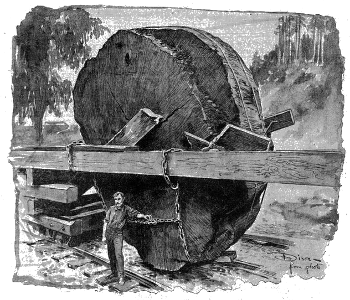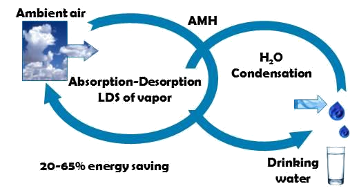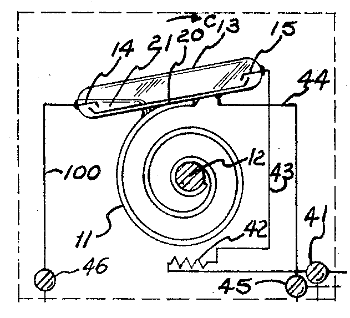It's the Humidity
August 22, 2016
Everyone has heard the
saying, "
It's not the heat, it's the humidity." Most
mornings at my
home in
Northern New Jersey, I'm reminded that there's a lot of
water in the
air. On cool
summer mornings, my
automobile is covered with a thick layer of water,
condensed as
dew from the
atmosphere. On some
winter mornings, the dew appears as a thick layer of
ice. In an
earlier article (Fog Water Harvesting, December 2, 2010), I did a "
spherical cow calculation" of how effective my automobile is at collecting dew.

The idea of a spherical cow makes fun of the tendency of physicists to simplify their problems.
(Portion of an illustration by Ingrid Kallick, via Wikimedia Commons.)
From observation, I estimated that a heavy dew covered my car with about a
liter of water.
Approximating the
geometry of the car as two
rectangular parallelepipeds, one atop the other, having about 220 square feet exposed to the air (about 20
square meters) when the
undercarriage is ignored. This results in a collection
efficiency of about 50
milliliters per square meter.
The world is trending towards a
water crisis because of
pollution of
potable water, and the competing
human and
industrial needs for water. Humans need about forty liters of water per day.
Trees are natural
fog water harvesters, as demonstrated by the trees planted by
Charles Darwin on Ascension Island, a dry volcanic island. After two decades, the
leaves of these trees were harvesting enough water to grow
crops to feed hundreds of
British troops.
Trees with
needle-like leaves are the best harvesters, especially the ones that have leaves oriented
vertically, rather than
horizontally. The
California Redwood (Sequoia sempervirens) is so adept at harvesting water from the air that wet microclimates are created at its base.[1]

Now, that's a tree!
A section of a California Redwood (Sequoia sempervirens).
(An 1899 newspaper image, via Wikimedia Commons.)
Fog water harvesting has been demonstrated using large plastic nets, 32 square meters in
area, in
Lima, Peru.[1] During the cooler months of May through
November, such nets have captured as much as 590 liters in a single day. A more elaborate, double-net system produced an
average of 300 liters per day throughout the year, with 2650 liters being produced in a single day.[1] While automobile
metal and
glass act as fog water harvesters, such plastic netting is more effective, since air can
flow though it.
Scientists at
Technion-Israel Institute of Technology (Haifa, Israel) have gone beyond such passive fog water harvesting methods by developing an active type of atmospheric moisture harvester. While such active systems require
energy, the Technion system separates the
water vapor from the air before cooling and condensation as an energy-saving method.[2-3]
The simplest active fog harvesting system would use
electrical refrigeration to condense water vapor through cooling, an energy-intensive process. The Technion system uses a
liquid desiccant that separates the water vapor from air, so that just the water vapor needs to be cooled. Using
computer modeling, they found a 5-65% percent energy savings using their technique, depending on
climate conditions and the use of supplemental
solar energy.[2]

In this image, LDS is "liquid-desiccant vapor separation," and AMH is "atmospheric moisture harvesting."
(American Chemical Society image.)
In a
recent article (Humidity Sensing, June 13, 2016), I reviewed
humidity-sensing technologies, some of which are based on changes in the the
mechanical properties of some
materials upon exposure to humidity. For example,
fibers such as
horsehair and
human hair will change
length or
twist when
braided as they
absorb water from the air.
Another example of a mechanical humidity sensor has an action similar to that of a
bimetallic thermometer. In such thermometers, the differential
thermal expansion of two bonded metal strips causes the
bimetallic strip to bend. A
salt-impregnated paper glued to a coil of
metal or another
elastic material that doesn't absorb water will similarly bend with changes in humidity.

Portion of fig. 1 of US Patent No. 3,284,002, "Control Apparatus," by Walter E. Edelman and David J. Sutton, October 26, 1964.
This is the iconic Honeywell T87 Round Thermostat containing a bimetallic element (11) that moves a mercury switch (13).
(Via Google Patents.)
Bimetallic strips can do a little
work in response to a temperature change, and the same is true for bimaterial humidity sensing strips.
low power wireless sensors that
harvest energy from a variety of
environmental sources, such as
light,
atmospheric pressure change, and
vibration, can harvest environmental energy, also, from humidity change. In most environments, the
diurnal variation in humidity is large.
Scientists and
engineers at the
RIKEN Center for Emergent Matter Science (CEMS, Hirosawa and Sayo-cho, Japan), and the
University of Tokyo (Tokyo, Japan) have used the water vapor absorptive property of an
anisotropic polymer to form an
actuator that responds to even small changes in humidity.[4-6] The polymer, produced as a
thin film of
carbon nitride by
physical vapor deposition from
guanidinium carbonate, is lightweight, but
durable.[4] The film straightens and curls upon exposure to very small changes in ambient humidity; and, exposure to
ultraviolet light affects its water absorption ability.[5]
As happens often in science, the humidity sensitivity of the material was unexpected, and it was discovered by
accident. Says
Daigo Miyajima of CEMS,
"Our study began from a serendipitous finding. When we placed a compound called guanidinium carbonate into a high-temperature oven, we found that it formed not only a powdery substance - as is usual in similar processes—but also a yellowish film that stuck to the surface of the substrate. The film was a carbon nitrite polymer composed of stacked polymers of heptazine oriented parallel to the surface of the substrate."[5]
When the
research team started to
analyze this unusual film, first removing it from its substrate using warm water, they noticed its tendency to bend and straighten, seemingly at
random intervals.[5] They found that this behavior arose from extremely small changes in the ambient humidity.[5] Moving a
drop of water into the vicinity of the film would cause it to straighten. A
weight difference was detected between the straight and curled states, the weight of the curled state being just 68
nanograms per
square millimeter greater than the curled state.[5] This film was seen to respond to quantities of water as small as a few hundred nanograms per 10 square millimeters.[4]

The bending of a film of carbon nitride polymer in response to humidity. (Left image and right image from RIKEN.)
It's proposed that water
molecules create mechanical
stress as they bond to the polymer, and this changes the film shape. The change caused by exposure to ultraviolet light is extremely rapid, of the order of 50
milliseconds, and this action could be repeated more than 10,000 times without deterioration of the film.[4-5]
Considerable
power was evident in the curling process. A film on a flat surface could jump to a one
centimeter height upon ultraviolet light induced curling, a distance ten thousand times the film thickness.[4-5] Such films have potential for environmental energy harvesting.[5-6]
References:
- Gaia Vince, "News Focus/Hydrology-Out of the Mist," Science, vol. 330, no. 6005 (November 5, 2010), pp. 750-751.
- Ben Gido, Eran Friedler, and David M. Broday, "Liquid-Desiccant Vapor Separation Reduces the Energy Requirements of Atmospheric Moisture Harvesting," Environ. Sci. Technol., Article ASAP (July 20, 2016), DOI: 10.1021/acs.est.6b01280.
- Harvesting water from air with less energy, American Chemical Society Press Release, July 20, 2016.
- Hiroki Arazoe, Daigo Miyajima, Kouki Akaike, Fumito Araoka, Emiko Sato, Takaaki Hikima, Masuki Kawamoto, and Takuzo Aida, "An autonomous actuator driven by fluctuations in ambient humidity," Nature Materials, advance online publication (July 18, 2016), doi:10.1038/nmat4693.
- Jens Wilkinson, "'Jumping film' harnesses the power of humidity," RIKEN Press Release, July 19, 2016.
- New film bends, straightens, jumps, and walks, using the power of humidity, YouTube Video, July 18, 2016.
Permanent Link to this article
Linked Keywords: Saying; It's not the heat, it's the humidity; morning; home; Northern New Jersey; water; atmosphere of Earth; air; summer; automobile; condensation; condense; dew; atmosphere; winter; ice; spherical cow calculation; habit; tendency; physicist; simplification; Wikimedia Commons; observation; liter; approximation; approximate; geometry; cuboid; rectangular parallelepiped; square foot; square feet; square meter; chassis; undercarriage; efficiency; milliliter; water security; water crisis; water pollution; drinking water; potable water; human; industry; industrial; tree; fog; Charles Darwin; Ascension Island; volcano; volcanic; decade; leaf; leaves; crop; British Empire; troop; foliage; needle-like; vertical; horizontal; California Redwood (Sequoia sempervirens); microclimate; plastic; net; area; Lima, Peru; May; November; average; metal; glass; airflow; scientist; Technion-Israel Institute of Technology (Haifa, Israel); energy; water vapor; electricity; electrical; refrigeration; liquid; desiccant; computer simulation; computer modeling; climate; solar energy; American Chemical Society; humidity sensor; hygrometer; humidity sensing; technology; mechanics; mechanical; material; fiber; horsehair; human hair; length; twist; braid; absorption; absorb; bimetallic strip; thermometer; thermal expansion; salt; metal; elasticity; elastic; cultural icon; iconic; Honeywell; T87 Round Thermostat; bimetallic element; mercury switch; Google Patents; work; low power; wireless sensor; energy harvesting; environment; light; atmospheric pressure; vibration; diurnal; engineer; RIKEN Center for Emergent Matter Science (CEMS, Hirosawa and Sayo-cho, Japan); University of Tokyo (Tokyo, Japan); anisotropy; anisotropic; polymer; actuator; coating; thin film; carbon nitride; physical vapor deposition; guanidinium; carbonate; toughness; durable; ultraviolet light; serendipity; accident; Daigo Miyajima; furnace; high-temperature oven; powder; substrate; heptazine; parallel; research; analytical chemistry; analyze; randomness; random; drop; weight; nanogram; square millimeter; molecules; shear stress; millisecond; power; centimeter.